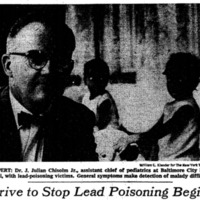J. Julian Chisolm and Demographics of a Public Health Crisis
Dublin Core
Title
J. Julian Chisolm and Demographics of a Public Health Crisis
Description
J. Julian Chisolm (1922-2001) was one of the first physicians to recognize lead poisoning and to use chelation therapy to treat it. (Markowitz, Rosner 48). But his greatest concern with lead was not its treatment, but rather its systematic integration into our environment. In the early fifties Chisolm obtained a fellowship to research the distribution of lead poisoning in Baltimore’s children looking for lead in stool samples he realized that exposure to lead had been severely underestimated (Markowitz, Rosner 48). He discovered that “children who ingested paint were getting more lead than heavily exposed workers” (Markowitz, Rosner 48). Moreover, he also recognized a significant disparity in the lead levels between the minority and white demographics. In a discussion with his student Ellen Silbergeld he explained that “he saw racism inherent in the societies lack of response to lead poisoning. ‘if this were a disease of white children,’ he told her ‘we would have done something about this a long time ago’” (Markowitz, Rosner 50).
In a 1985 study, Chisolm and some colleagues wanted to test the lead exposure rate of different home environments, they followed 184 children who had already been exposed to high levels of lead for a year and grouped them based on their housing quality. What they found was that 40% of the initial group had to be re-treated with chelation therapy, and 50% of that group had to be treated yet again (Markowitz, Rosner 129). Chisolm was frustrated with the way he would continually treat patients for lead poisoning and then send them back into environments that poisoned them in the first place, this was not a working solution. To make this worse “if survivors of an initial attack of acute lead encephalopathy are re-exposed to abnormal lead exposure the incidence of severe permeant brain damage is increased to virtually 100%” making the long-term effects of lead-exposure that much more dangerous (Markowitz, Rosner 51). After seeing some of the same patients come in time and time again, he championed the idea of the “systematic elimination of environmental lead exposure” with a specific focus on older buildings that were more likely to contain lead-based paint (Markowitz, Rosner 51).
This is a great idea but unfortunately as Chisolm already noted most of the patients, he received were from minority population in low income housing without the capital to clean their own environments. After seeing patients and families suffering first hand for so long Chisolm dedicated himself to “implementation of policies regarding low-level lead exposure” as the most effective way he could continue to mitigate the effects of lead. He believed in the idea that the government, as well as wealthy land lords, had an obligation to support the effected public financially (Markowitz, Rosner 144). Chisolm aimed to make Baltimore a city that others could follow in their efforts to remove environmental lead, he wanted to create new protocols for the abatement of lead that had lasting effect (Markowitz, Rosner 149). Chisolm was also realistic, he “accepted the political limitations that were imposed on public health and argued for ‘introducing interim measures’ that could ‘protect thousands of children until we can eliminate this preventable disease all together’” (Markowitz, Rosner 230).
In a 1985 study, Chisolm and some colleagues wanted to test the lead exposure rate of different home environments, they followed 184 children who had already been exposed to high levels of lead for a year and grouped them based on their housing quality. What they found was that 40% of the initial group had to be re-treated with chelation therapy, and 50% of that group had to be treated yet again (Markowitz, Rosner 129). Chisolm was frustrated with the way he would continually treat patients for lead poisoning and then send them back into environments that poisoned them in the first place, this was not a working solution. To make this worse “if survivors of an initial attack of acute lead encephalopathy are re-exposed to abnormal lead exposure the incidence of severe permeant brain damage is increased to virtually 100%” making the long-term effects of lead-exposure that much more dangerous (Markowitz, Rosner 51). After seeing some of the same patients come in time and time again, he championed the idea of the “systematic elimination of environmental lead exposure” with a specific focus on older buildings that were more likely to contain lead-based paint (Markowitz, Rosner 51).
This is a great idea but unfortunately as Chisolm already noted most of the patients, he received were from minority population in low income housing without the capital to clean their own environments. After seeing patients and families suffering first hand for so long Chisolm dedicated himself to “implementation of policies regarding low-level lead exposure” as the most effective way he could continue to mitigate the effects of lead. He believed in the idea that the government, as well as wealthy land lords, had an obligation to support the effected public financially (Markowitz, Rosner 144). Chisolm aimed to make Baltimore a city that others could follow in their efforts to remove environmental lead, he wanted to create new protocols for the abatement of lead that had lasting effect (Markowitz, Rosner 149). Chisolm was also realistic, he “accepted the political limitations that were imposed on public health and argued for ‘introducing interim measures’ that could ‘protect thousands of children until we can eliminate this preventable disease all together’” (Markowitz, Rosner 230).
Creator
William Klender
Publisher
The New York Times
Date
Nineteen fifties through the eighties.
Contributor
David McGuire
Meghan Thornton
Meghan Thornton
Collection
Citation
William Klender, “J. Julian Chisolm and Demographics of a Public Health Crisis,” History of Environmental Inequalities, accessed April 30, 2024, https://steppingintothemap.com/inequalities/items/show/54.
Embed
Copy the code below into your web page
